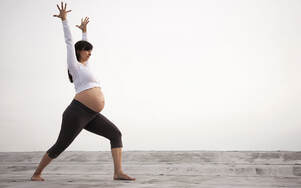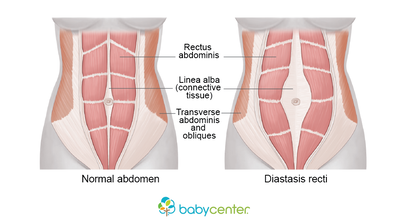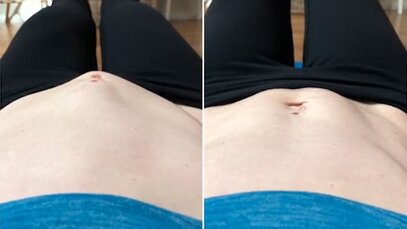
First, congrats to you if you’re pregnant! And kudos to you if you’re still trying to workout while pregnant! If you are like me, you’re probably experiencing a whirlwind of emotions and thoughts and just want the best for your baby, which is why you’ve ended up here. You’re trying to maintain your physical fitness so you can give your growing baby the best environment to develop in. However, it’s tough to know what is and isn’t safe or what the best recommendations are and the lack of evidence/controversial research doesn’t make it any easier. BUT, hopefully this blog will provide some clarity to your situation!
There are A LOT of changes that occur in the human body when pregnant. To accommodate the growing baby and the enlarging uterus, your organs have to do some moving around. As the baby grows, the lungs get pushed upwards, your intestines/bladder get squished, and your abdominal muscles have to stretch and may even separate. You may also start to experience various aches and pains and even changes in balance and posture. With all of these changes occurring in the body, I bet you’re wondering if there’s anything that we can do to affect this process or if it’s all inevitable. Well, you’re in luck! Your actions during pregnancy CAN influence some of these symptoms, which is why I’d like to talk about performing abdominal exercises while pregnant. This is one of the most controversial topics relating to pregnant women. Thankfully, working out while pregnant is becoming a little more accepted,(1) but core exercises on the other hand… a much touchier subject! Are they safe to do? Are they healthy to do? How do I know which exercises are safe and which exercises aren’t? Am I putting my body or baby at risk? Keep reading for answers!!
If you haven’t already, I would make sure you have an OBGYN and physical therapist that you trust! Ideally, they’d both work closely together to give you the best advice for YOUR individual body at each stage of your pregnancy. You want to make sure whoever you’re taking advice from is active and knows about the sport/hobbies you are interested in so they can help guide you on this journey. I would advise AGAINST someone who gives you the same cookie cutter advice they give all moms. For instance, I’ve been active in sports my whole life, played college soccer, have been competing in Crossfit for 5 years, and then got pregnant. My first OB told me I should take it easy, only do light to moderate activity, not elevate my heart rate, not lift over 35 pounds, and definitely NO core exercises. *News Flash*: this is OLD advice that is very outdated! And if you don’t know any better and don’t do your own research, then how would you know?? If you are a CrossFitter, here’s some more reasons why you need a CrossFit Physical Therapist!
9 times out of 10, if you’ve been working out or doing the activity consistently BEFORE getting pregnant, then you’re likely going to be able to continue doing that activity WHILE pregnant, as long as you’re being safe and smart.(2) Ask yourself, “Does the risk outweigh the reward?” When it comes to core exercises while pregnant, the reward IS there and here’s why!

As I mentioned previously, many changes that occur in the body while pregnant are stretching of the abdominal wall, aches and pains (usually in the back), and changes in balance and posture. ALL of these changes can be influenced by the STABILITY/STRENGTH of your core! The weaker your muscles are, the more apt they are to stretching, which can lead to Diastasis Recti. This then affects your posture and will likely increase the amount of aches and pains that you experience during pregnancy, especially in your back.
What is Diastasis Recti?
Diastasis recti occurs when the uterus stretches the muscles in the abdomen to accommodate your growing baby and ends up creating a space between your abdominal muscles. This separation is actually a common occurrence and 2 out of 3 pregnant women will experience this. In many cases, the linea alba (the midline of your abs) naturally regains tension after pregnancy and the gap separating the two abdominal muscles closes on its own. But, when the space doesn’t close and is bigger than 2 finger widths wide, it could become a problem and make recovery tough. According to research, women are at an increased risk for developing this excessive separation if they are over the age of 35, obese, have had multiple births, or have a WEAK CORE. Maintaining a strong core and healthy weight with exercise before, during, and after pregnancy is undoubtedly the BEST method to avoid diastasis recti. (3)

No, not ALL core exercises are safe or recommended while pregnant, but it is beneficial for you to find the ones that are…and here’s how: It’s important to understand that there’s a difference between core STRENGTHENING and core STABILITY and core STABILITY is what’s needed when growing a tiny human!
Lots of programs and exercises “strengthen” the core. These are the exercises that we’re probably most familiar with and involve direct movement within the core. They’re the exercises that most of us commonly do to build a 6-pack such as russian twists, sit ups, crunches, V-ups, leg raises, reverse crunches, and GHD sit ups. “Stability” is different and is often a component that is lacking from most programs because the exercises aren’t as glamorous. They’re exercises that don’t involve movement of your abs, such as a standard plank, side plank, med ball stirs, and pallof variations (see videos below). These exercises are much safer alternatives to perform while pregnant as they do not cause excessive strain to the rectus abdominis (your 6-pack muscles) and focus on 360 degree core stability. (4) They’re also the exercises that will help ward off pain, excessive changes in posture and muscle length, and even constipation, bloating, and urine leakage.
However, it’s still important that you know what your body can and can’t handle. For instance, just because someone else is pregnant and can perform a plank, doesn’t mean that everyone else that is pregnant can and vice versa! It’s important that you know what to be aware of while performing these exercises (and any other activities).
Be sure to avoid excessive coning, bulging, the feeling that you’re unable to control your core, an increase in the amount of pressure in your pelvic floor, or an increased need to pee (to name a few). If any of this occurs, alter the movement. Simple as that. The coning is our body’s way of giving us feedback and just tells us where the pressure distribution is in our body. Now, excessive coning done repeatedly over time is what could lead to an abnormal widening of your abdominal muscles and could make recovery a lot tougher. For this reason, I recommend adjusting each exercise as necessary so you can then successfully avoid the coning.

With all that being said, I do NOT recommend that you start up a strengthening program for the first time while pregnant and it is ALWAYS recommended that you consult with your doctor or a medical professional before doing anything! This post is NOT intended to be a prescription for what you should or shouldn’t do during pregnancy. You need an individualized program tailored toward your body! What this post IS intended for is to empower you and make you aware of some of the changes that are likely to occur throughout your pregnancy and hopefully give you a sigh of relief because now you know you can do something about it!

Are you pregnant and looking for doctor in Charlotte who understands that movement IS GOOD? Feel free to reach out to us to start a conversation!
Thanks for reading!
– Dr. Aerial
References
1. Hammer, R. L., Perkins, J., & Parr, R. (2000). Exercise during the childbearing year. Journal of Perinatal Education, 9(1), 1–13. https://doi.org/10.1624/105812400×87455
2. Physical activity and exercise during pregnancy and the postpartum period. (2020). Obstetrics & Gynecology, 135(4). https://doi.org/10.1097/aog.0000000000003772
3. Rebelle, T. (n.d.). How to prevent Diastasis Recti (with crunches). NASM. Retrieved March 2, 2022, from https://blog.nasm.org/womens-fitness/how-to-prevent-diastasis-recti-with-crunches
4. Chiarello, C. M., Falzone, L. A., McCaslin, K. E., Patel, M. N., & Ulery, K. R. (2005). The effects of an exercise program on diastasis recti abdominis in pregnant women. Journal of Women’s Health Physical Therapy, 29(1), 11–16. https://doi.org/10.1097/01274882-200529010-00003


4 Responses
Everything is very open with a clear clarification of the issues. It was definitely informative. Your site is extremely helpful. Thanks for sharing!
That is great to hear that you were able to clear up a few the questions you had! Feel free to check out our Instagram @thecharlotteathlete for more tips surrounding physical therapy and exercising while pregnant.
Hey! This post couldn’t be written any better! Reading this post reminds me of my old room mate! He always kept chatting about this. I will forward this post to him. Pretty sure he will have a good read. Thank you for sharing!
Wow! There is so much good stuff in this post! You’re also an extraordinary writer. I can’t wait to read more of your writing. Do you have Twitter?